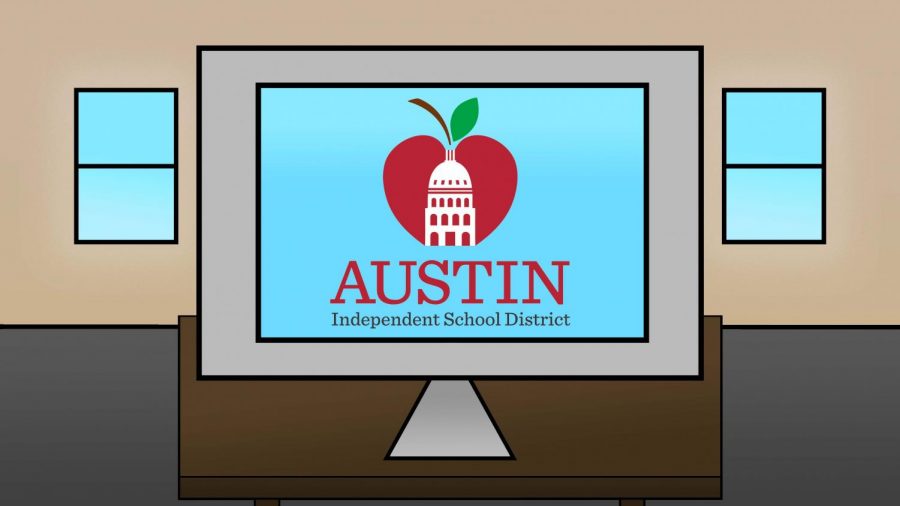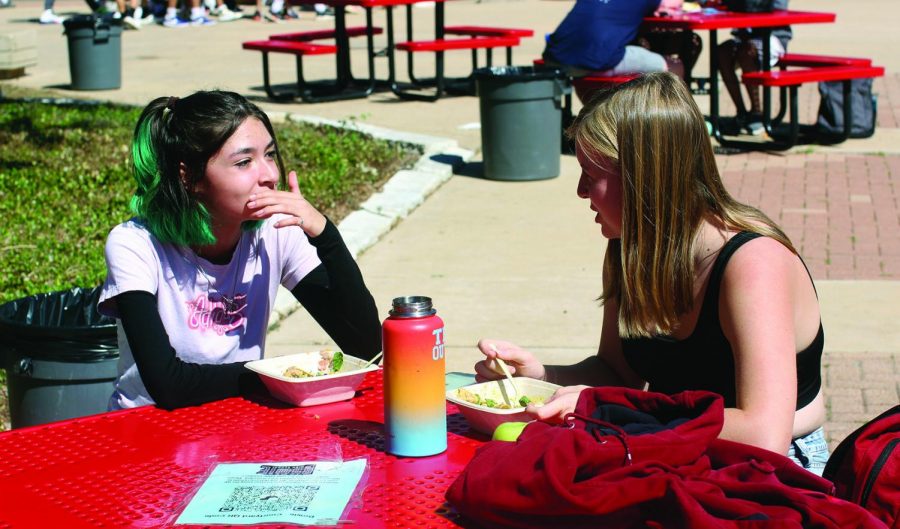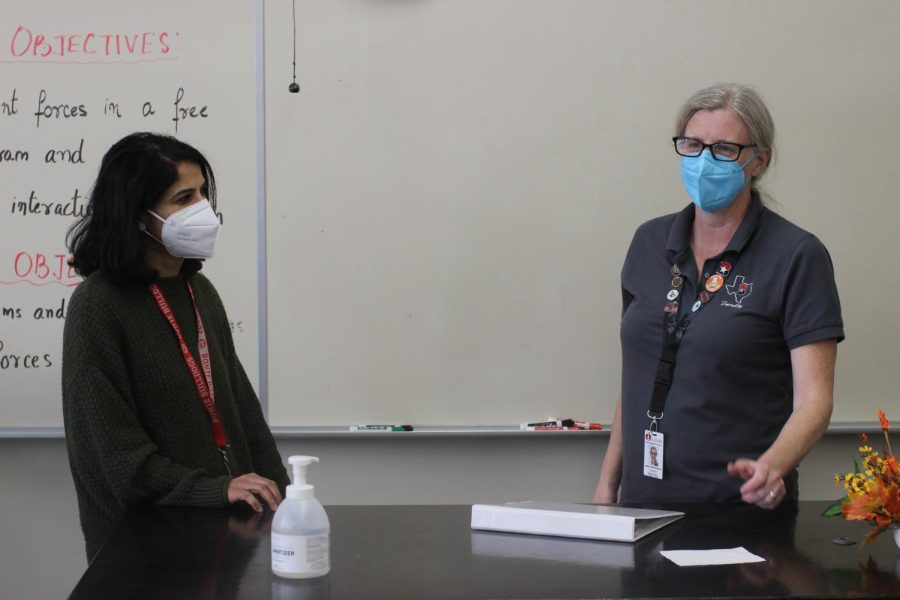During this school year, only K-6 students had virtual offerings for at-home learning. As a result, most middle and high school students attend school on campus.
AISD limits virtual offerings to K-6 students
October 12, 2021
In June of this year, AISD stated that kindergarten to sixth grade students will be qualified for virtual offerings. Originally, AISD announced that all students would be back and learning in person, but this later changed for K-6 students. AISD acknowledged that those eligible for the vaccine don’t require virtual learning due to the ineffectiveness and limited resources.
Students, especially Pre-K, experienced development issues during virtual learning compared to in person. According to the Virtual Learning FAQs for AISD, limited interactions and technology were the main contributors to this struggle, as such it was decided that only those with health risks, and susceptibility to the virus, would be permitted to proceed with online learning.
“There are no virtual options for high school. The virtual options the district is providing are for ages 12 and down, not up,” Academic Director Kaylin Brett said. “Since young children are not eligible for the vaccine yet, the district is allowing Kindergarten through six grade virtual options.”
Currently there’s another option for students who are at risk of in person learning. Homebound, a program for students with high risk and special needs allows students to attend school from home while still being counted present. This has been in effect before COVID and is most often offered to those confined at home or the hospital. However, the Homebound Instruction Overview for AISD requires a doctor to write up why a student would need to be confined for a month or more, but it is not the determining factor.
“High schools can qualify, it just has to be a special education thing,” Counselor Hunter Ruffin said. “Through special education, you might qualify [via] application process.”
At Bowie high school, because of the eligibility for the vaccine, no virtual offerings are conducted. However, there are a few semi-virtual courses and programs offered. One such program involves teaming up with Garza High School Online, a school that provides opportunities to obtain credits that is often seen with students trying to graduate early. Anyone in grades 9-12 attending AISD are capable of enrolling in the program with a written permission from their counselor/administrator.
“Garza does have some online options. Bowie students still have to be in at least 6 classes at Bowie to also take an online class at Garza,” Brett said. “Typically a student will do one or two online classes through Garza online while simultaneously going through courses at Bowie.”
A more known Garza addition at Bowie, is Health in the summer. This was primarily done for students that wanted to get rid of the required health credit in a quicker and easier way. According to the Course List in the Garza High School Website, there’s more than just health. They’ve got all four science courses, the four English classes, they’ve got math, all the way up to Algebra Two, and they have all the social studies except World Geography. There’s also computer science, creative writing, and other various electives that can be taken through Garza.
“It’s not super marketed because we want people signing up for classes at Bowie, but if anytime a kid would come to our office and say ‘hey, how do I get ahead?’ or ‘how do I catch up?’ . . . then [one] answer would be, ‘well there’s this Garza high school thing, you could try that,’” Ruffin said. “And so it’s kind of like the third option.”
The only other semi-virtual program at Bowie is called DELTA. DELTA is a course recovery program for those that failed a past semester in any subject. Once the course is completed students can supplement it with an off period.The DELTA program is entirely self paced, similar to Garza.
“DELTA is a class period throughout the day. [It] could be scheduled in any of the period[s] one through eight,” Ruffin said. “DELTA has kind of always been the number one credit recovery option for juniors and seniors.”
Students adjust to new COVID response and protocols
ENJOYING LUNCH: Seniors Kinsey Quintanilla and Reese Wilson distancing maskless during their lunch period. The two seniors spend their time in the courtyard to social distance from large groups.
COVID-19 was declared a global pandemic in March of 2020. Since then, there have been many regulations implemented to mitigate the spread of the virus. Common recommendations for protection against COVID-19 is to get vaccinated, wear a mask, get tested, washing hands, and social distancing
In addition to these suggestions, the district has instituted other protocols to protect student like mandatory mask usage, rapid testing, and contract tracing. Along with Bowie’s new protocols, a committee led by assistant principal Jerry Smith has been established to handle Bowie’s COVID-19 response. This team is in charge of mitigation of the virus, as well as ensuring staff and students’ safety.
“It’s definitely a new challenge,” Smith said. “No one likes wearing masks all of the time, and it does present its own challenges with being able to communicate as well as we usually do. It’s a bit of a frustration but the majority of our staff and students are doing very well.”
In March of this year, Texas’ Governor Greg Abbott issued Executive Order GA No. 36, prohibiting schools from enforcing their own mask mandates. Despite this the Houston, Dallas, and Austin school districts have all instituted their own rules enforcing the use of face-coverings. AISD Superintendent Stephanie S. Elizalde announced in August, all students, staff, and visitors must wear face coverings on AISD property.
“I am responsible for the safety, health and welfare of each and every one of our students and our staff,” Elizalde said. “I must be on the side of ensuring that we’ve been overly cautious, not that we have fallen short.”
Last year students had the option to return to school for hybrid learning, where they got the option to take some classes in- person and some classes online. Students participating in this hybrid model went to school two to three days a week and spent the rest of the time doing remote learning. This plan offered the use of social distancing, as there were only about 200-300 students attending school in person each day. Now that all students have returned to campus, distancing has become more of an issue.
“There was a lot more freedom last year,” junior Danielle Cross said. “Now the teachers are less relaxed, and they’re stricter about masks now because there’s so many kids. It’s a big adjustment, going from there being less than 200 kids in the school, and now there’s almost 3000 kids.”
Students, for the most part, have been following these guidelines pretty closely. According to Smith, masks have proven an important and useful tool to the regulation of COVID-19. All of last school year AISD required masks for hybrid learners resulting in a lower positivity rate inside its schools than in the community at large.
“You always had to wear a mask, but there were definitely a lot of people that didn’t want to,” Cross said. “And because there was so few kids in the classroom, you were always well more than six feet apart from each other.”
Compulsory masks aren’t the only method Bowie is using to protect its students. Since students have returned to in-person learning, the new practice of contact tracing has emerged. Contact tracing is the process of tracking who staff and students come in contact with, alerting the school when any person has come in close proximity to any infected individual.
“I think contact tracing is a good idea in theory, but I’m not sure how effective it is in practice, because a lot of students don’t care all that much,” sophomore Charlotte Hill said. “Personally, I support contact tracing.”
When Smith and his team are notified of a positive case, they check the QR codes to find out where they eat lunch and who they have eaten lunch with. They also interview any positive students to see if they’re participating in any sports, extracurricular activities, or clubs.
“We have to get all of those questions answered, so we can let everyone know that they may have been exposed to COVID-19, and keep them safe,” Smith said.
Students are also encouraged to stay home whenever they feel sick or think they might have come into contact with the virus. There are expected spikes in absences, so teaching methods and attendance records have been adjusted. Students who in quarantine will have excused absences, and attendance incentives were canceled at the beginning of the year.
“We encourage our teachers to use BLEND as much as possible to reach out to students that are in quarantine,” Smith said. “And they don’t have to worry about accumulating absences that will impact them negatively.”
Earlier this year, the Delta variant of COVID-19 made its way to the United States and has by now become the predominant strain of the virus. The Delta variant is much more contagious, especially to children 12 and under, yet there is no vaccine approved for children aged 5-12 in the U.S.
“[COVID] is like the flu in a sense, because there’s multiple strands of it, and you got to get your flu shot every year,” Cross said. “And since it’s so new, there’s gonna be a lot more strands than just Delta and [COVID-19].”
Although it isn’t required, students are strongly encouraged to get COVID-19 vaccinations. Students who are fully vaccinated aren’t required to quarantine if they come into close contact with the virus, while unvaccinated personnel will need to stay home regardless of whether or not masks were worn. This COVID mitigation protocol is in place to prevent the contamination of anyone who hasn’t been vaccinated, especially with the Delta variant’s impact on adolescents.
“I think quarantining if you’re unvaccinated and come into close contact with COVID is a good idea, even if masks are worn, because you are at a significantly higher risk of the virus if unvaccinated,” Hill said. “Quarantining is about preventing exposure to other students, so morally I think it’s the right thing to do.”
Although all of the district’s suggestions are being followed, there have still been some students who have caught the virus. Some students feel that there’s more the school could do to mitigate the spread. Some believe there’s plenty of room for improvement, and have made suggestions for better maintenance of everyone’s health.
“I think that they should do it back to where it was online and in person again, because I know not everyone feels 100% comfortable being here,” Cross said. “And so for those students that want to stay home, they should be able to have that choice.”
Bowie has made numerous amounts of protocols to slow the spread of the COVID-19 virus. According to AISD Board President Geronimo Rodriguez, these protocols are especially important for the protection of the districts’ students who can’t get vaccinated at this time. Smith and his team believe that these regulations are crucial to the containment of COVID-19, and following them is the best way to remain safe in school.
“Even though it’s frustrating to wear a mask all the time, and do these different things, the Bowie staff and students are doing an amazing job, wearing their masks and following the protocols,” Smith said. “They’re just amazing to work with and they’re doing an excellent job of keeping everybody safe.”
First nine weeks teacher shortages
Chemistry teacher Jeanne Westmoreland and Bharti Sharma discuss the lesson plans for the next week. Before Sharma joined Bowie, Westmoreland was covering her classes along with her own.
It’s Monday morning, and you wake up feeling sick. You call in to inform the administration when they tell you there might not be a teacher to take your classes for the day.
As you put down the phone, you feel your stress levels starting to spiral, as you think of all the things that could go wrong in your classroom without a teacher there.
Although you feel terrible, you have to ask, is it worth it to go into school to make sure the students are being safe? This is the life of many teachers right now due to the profound shortage of teachers in Texas.
“There is a worker shortage everywhere, and admin has had a hard time finding enough qualified people who applied for the teaching jobs that we have had open,” chemistry teacher Jeanne Westmoreland said.
Specifically, at Bowie, there were various classes, especially in the science department, without teachers. For the first few weeks of the school year, these classes had no teacher and were being taught by substitutes and other teachers who chose to fill in.
“It took nearly six weeks for them to hire a teacher,” Westmoreland said. “Through these six weeks, there was no official teacher, so I was supporting a substitute by putting all the work on Blend and taking care of all the grades for the students in those classes, in addition to my own.”
At the beginning of this school year, especially with the return from an online school, there were not many teachers or substitutes applying. This caused many teachers to not only have to teach and prepare their own classes but also manage the additional stress of teaching a class that isn’t theirs.
“We are having trouble finding substitutes, and that is definitely affecting a lot of teachers who are having to cover classes for their colleagues during their conference periods,” Westmoreland said.
Some teachers have helped out by teaching another class during their conference period and creating lesson plans for other classes while on their break. While this caused more stress on the teachers, it also caused stress for the students who didn’t have a teacher.
“Without a teacher, we all had to teach ourselves just off of Blend so it was really hard because the sub there didn’t know anything about the subject,” sophomore Josy Stevens said. “We were expected to watch videos and take notes on our own and practically teach ourselves the subject, so a lot of kids didn’t do it.”
Although many classes were able to find other substitutes or teachers, not having one who can explain the materials correctly made it more difficult for students to prepare for tests and quizzes taken in those classes.
“It was really hard because I felt like I was never really prepared for the tests because I didn’t know if I was teaching myself the right things or not,” Stevens said.
Even though it has caused added stress to the lives of teachers at Bowie, they continue to help each other with filling in for classes to make sure the students are able to properly learn the material.
“We want to do the best for the students,” Westmoreland said. “So we sort of pick up the slack where there aren’t teachers or subs to fill the jobs.”


